Floor Advertising in Oman: Customer Perception Effectiveness
VerifiedAdded on 2023/06/03
|10
|2258
|139
Report
AI Summary
This report evaluates an article on the effectiveness of floor advertisements in Oman's retail sector, focusing on customer perception and behavior. The analysis covers the article's objectives, theoretical framework, methodology, and contribution to the Omani retail market. While the article aims to understand the impact of floor ads on customer decisions, the evaluation reveals shortcomings in addressing customer expectations and Omani-specific behavior. The survey's limited representation of the Omani population and unclear data presentation are also critiqued. Despite these limitations, the report acknowledges the article's contribution to understanding the relationship between floor ad effectiveness and various factors like persuasiveness and purchase intentions, suggesting avenues for further research. Desklib offers this report along with other solved assignments and past papers for students.
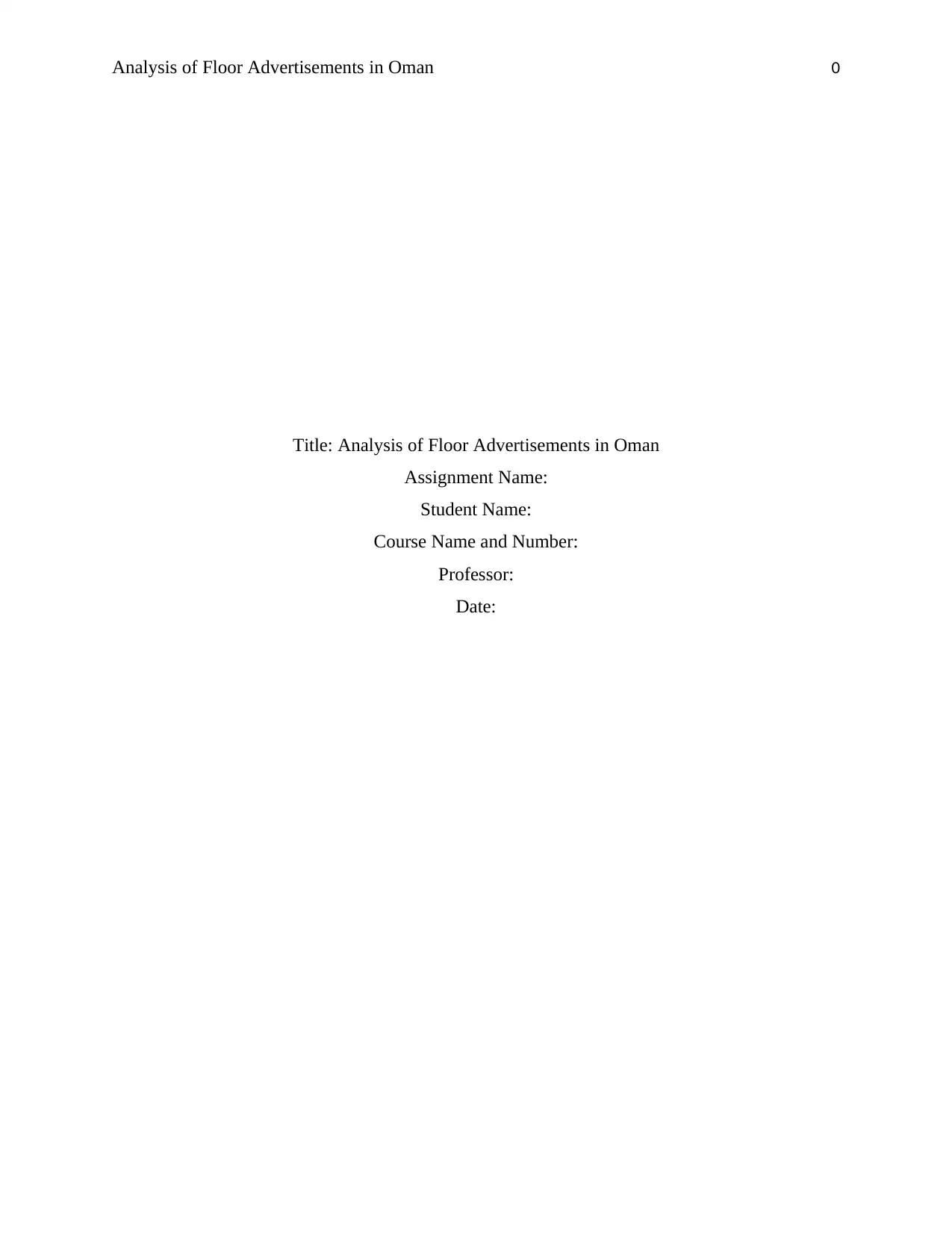
Analysis of Floor Advertisements in Oman 0
Title: Analysis of Floor Advertisements in Oman
Assignment Name:
Student Name:
Course Name and Number:
Professor:
Date:
Title: Analysis of Floor Advertisements in Oman
Assignment Name:
Student Name:
Course Name and Number:
Professor:
Date:
Secure Best Marks with AI Grader
Need help grading? Try our AI Grader for instant feedback on your assignments.
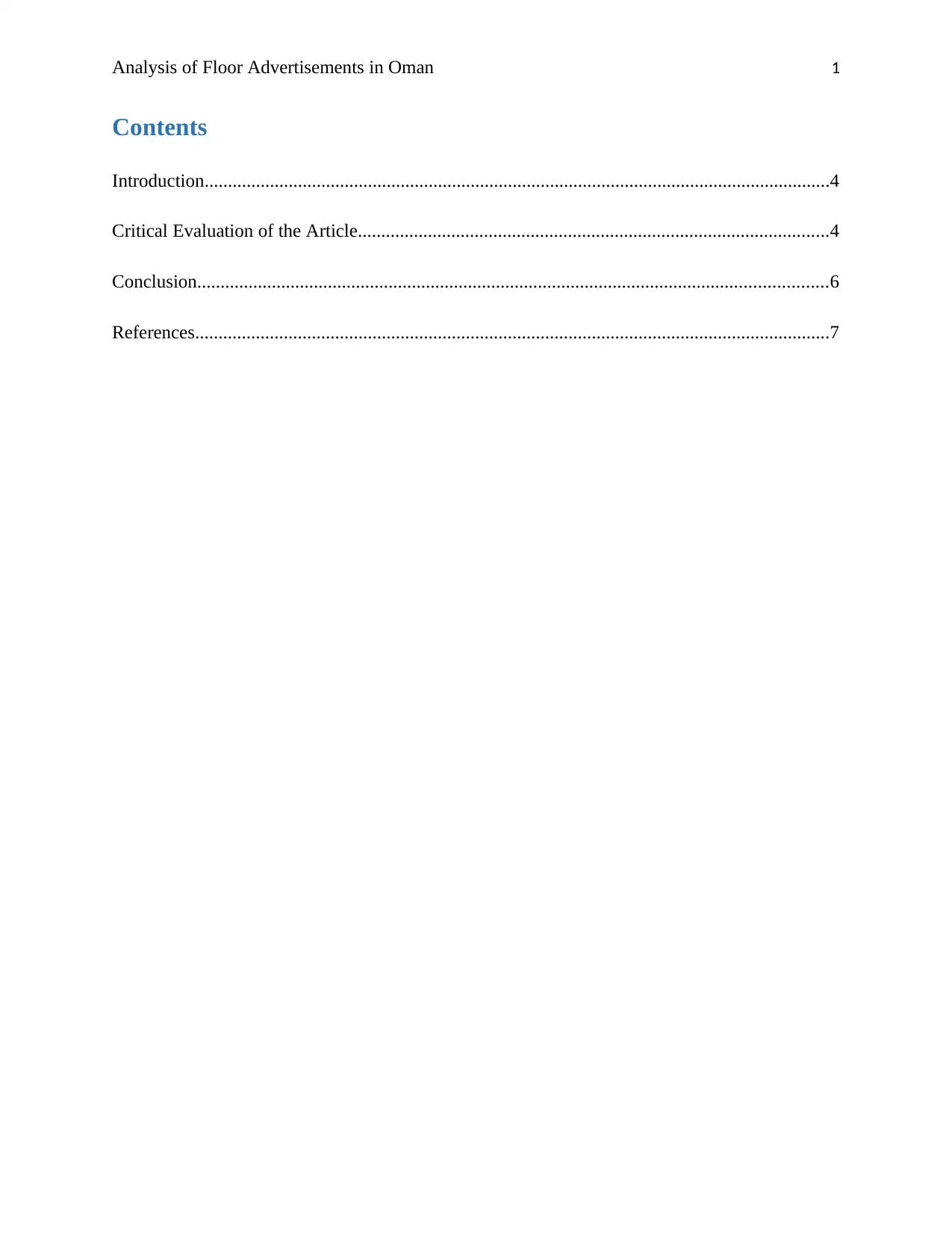
Analysis of Floor Advertisements in Oman 1
Contents
Introduction......................................................................................................................................4
Critical Evaluation of the Article.....................................................................................................4
Conclusion.......................................................................................................................................6
References........................................................................................................................................7
Contents
Introduction......................................................................................................................................4
Critical Evaluation of the Article.....................................................................................................4
Conclusion.......................................................................................................................................6
References........................................................................................................................................7
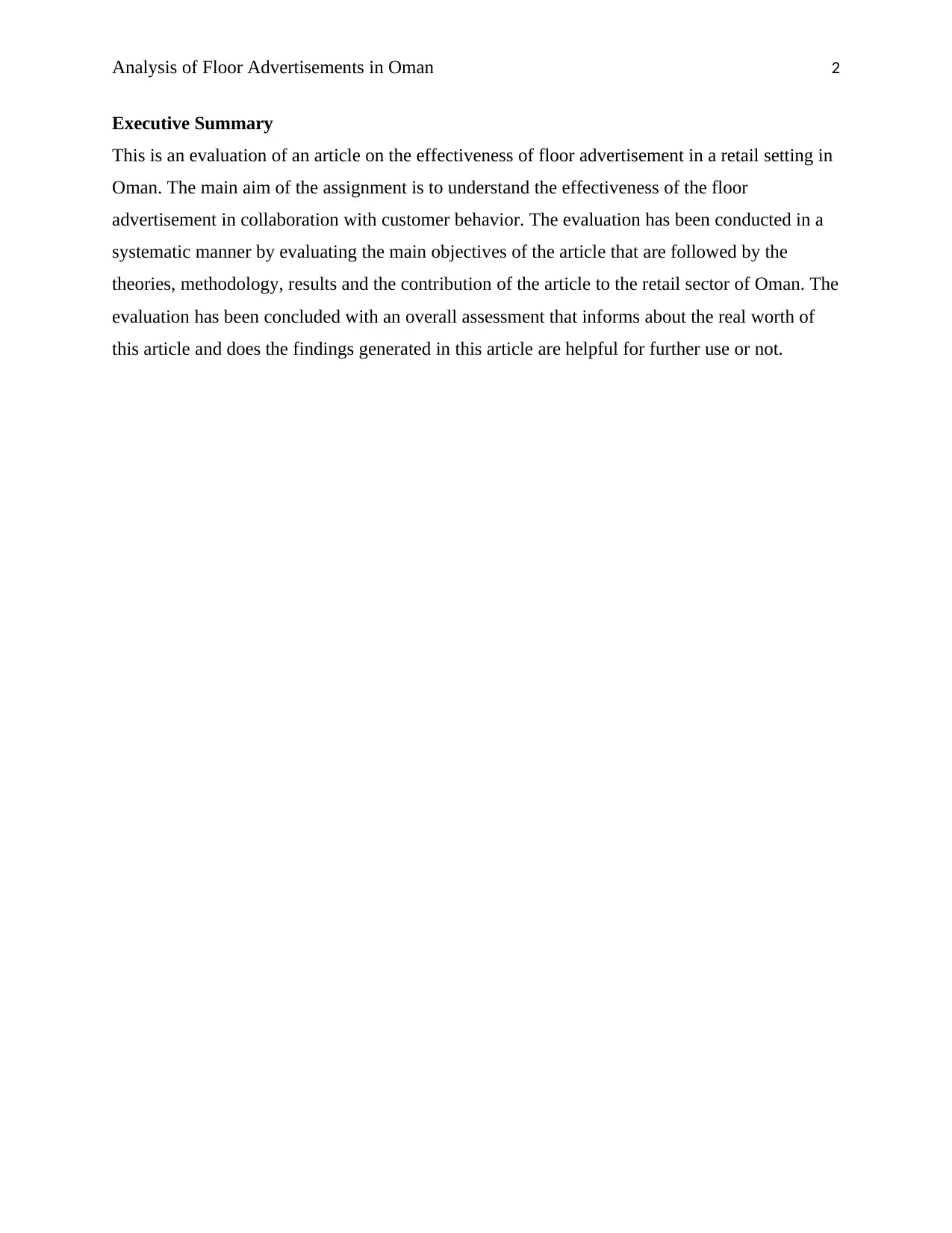
Analysis of Floor Advertisements in Oman 2
Executive Summary
This is an evaluation of an article on the effectiveness of floor advertisement in a retail setting in
Oman. The main aim of the assignment is to understand the effectiveness of the floor
advertisement in collaboration with customer behavior. The evaluation has been conducted in a
systematic manner by evaluating the main objectives of the article that are followed by the
theories, methodology, results and the contribution of the article to the retail sector of Oman. The
evaluation has been concluded with an overall assessment that informs about the real worth of
this article and does the findings generated in this article are helpful for further use or not.
Executive Summary
This is an evaluation of an article on the effectiveness of floor advertisement in a retail setting in
Oman. The main aim of the assignment is to understand the effectiveness of the floor
advertisement in collaboration with customer behavior. The evaluation has been conducted in a
systematic manner by evaluating the main objectives of the article that are followed by the
theories, methodology, results and the contribution of the article to the retail sector of Oman. The
evaluation has been concluded with an overall assessment that informs about the real worth of
this article and does the findings generated in this article are helpful for further use or not.
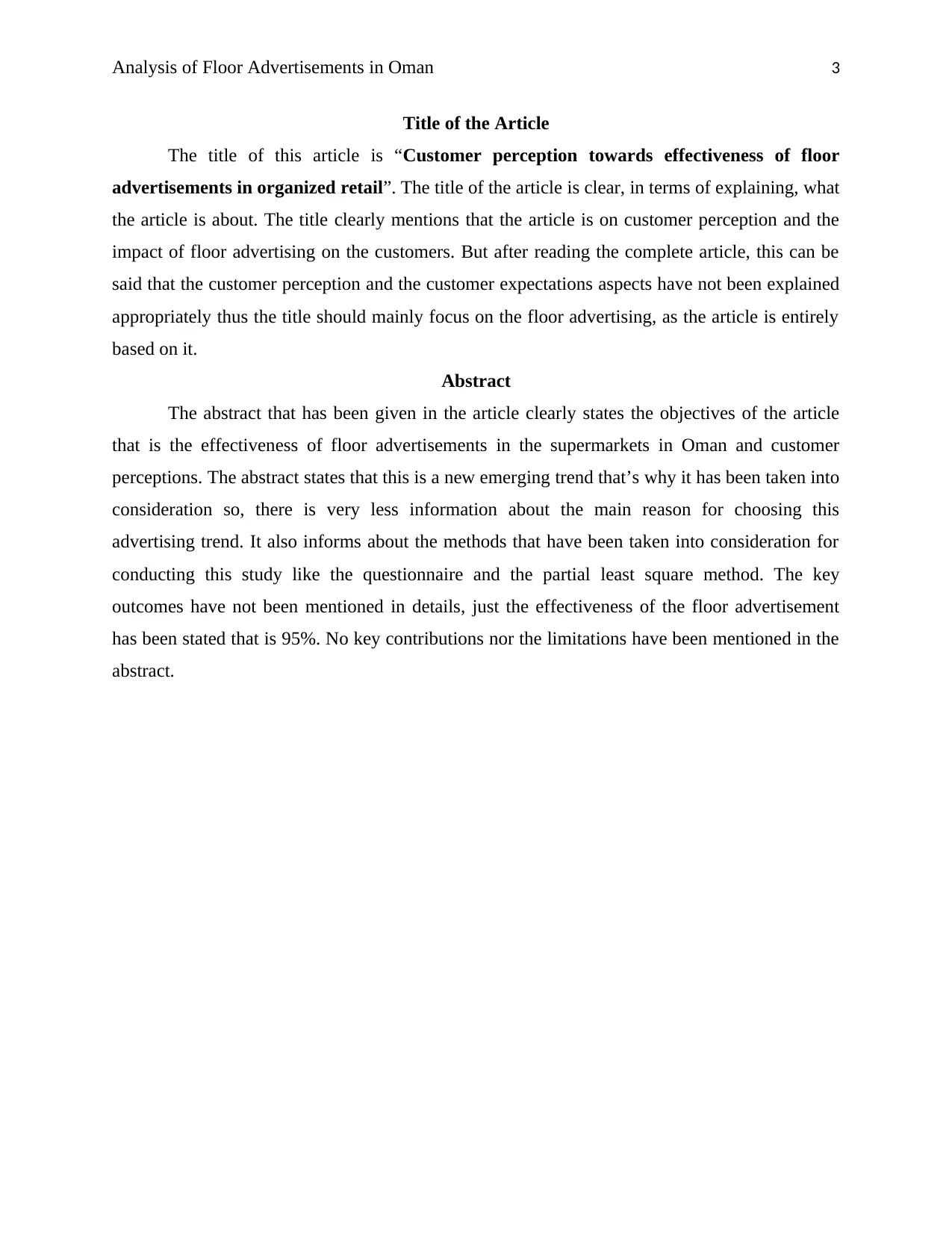
Analysis of Floor Advertisements in Oman 3
Title of the Article
The title of this article is “Customer perception towards effectiveness of floor
advertisements in organized retail”. The title of the article is clear, in terms of explaining, what
the article is about. The title clearly mentions that the article is on customer perception and the
impact of floor advertising on the customers. But after reading the complete article, this can be
said that the customer perception and the customer expectations aspects have not been explained
appropriately thus the title should mainly focus on the floor advertising, as the article is entirely
based on it.
Abstract
The abstract that has been given in the article clearly states the objectives of the article
that is the effectiveness of floor advertisements in the supermarkets in Oman and customer
perceptions. The abstract states that this is a new emerging trend that’s why it has been taken into
consideration so, there is very less information about the main reason for choosing this
advertising trend. It also informs about the methods that have been taken into consideration for
conducting this study like the questionnaire and the partial least square method. The key
outcomes have not been mentioned in details, just the effectiveness of the floor advertisement
has been stated that is 95%. No key contributions nor the limitations have been mentioned in the
abstract.
Title of the Article
The title of this article is “Customer perception towards effectiveness of floor
advertisements in organized retail”. The title of the article is clear, in terms of explaining, what
the article is about. The title clearly mentions that the article is on customer perception and the
impact of floor advertising on the customers. But after reading the complete article, this can be
said that the customer perception and the customer expectations aspects have not been explained
appropriately thus the title should mainly focus on the floor advertising, as the article is entirely
based on it.
Abstract
The abstract that has been given in the article clearly states the objectives of the article
that is the effectiveness of floor advertisements in the supermarkets in Oman and customer
perceptions. The abstract states that this is a new emerging trend that’s why it has been taken into
consideration so, there is very less information about the main reason for choosing this
advertising trend. It also informs about the methods that have been taken into consideration for
conducting this study like the questionnaire and the partial least square method. The key
outcomes have not been mentioned in details, just the effectiveness of the floor advertisement
has been stated that is 95%. No key contributions nor the limitations have been mentioned in the
abstract.
Secure Best Marks with AI Grader
Need help grading? Try our AI Grader for instant feedback on your assignments.
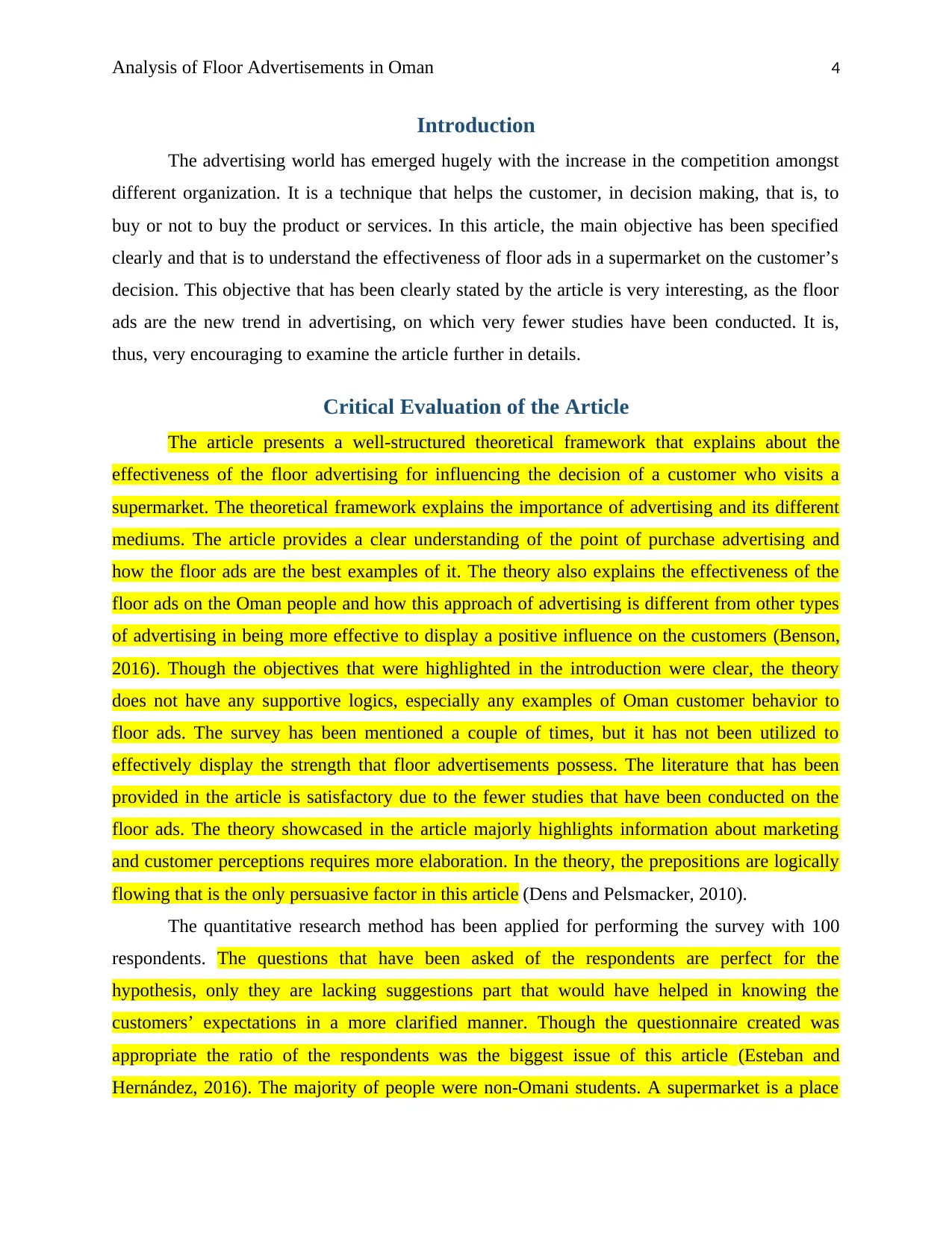
Analysis of Floor Advertisements in Oman 4
Introduction
The advertising world has emerged hugely with the increase in the competition amongst
different organization. It is a technique that helps the customer, in decision making, that is, to
buy or not to buy the product or services. In this article, the main objective has been specified
clearly and that is to understand the effectiveness of floor ads in a supermarket on the customer’s
decision. This objective that has been clearly stated by the article is very interesting, as the floor
ads are the new trend in advertising, on which very fewer studies have been conducted. It is,
thus, very encouraging to examine the article further in details.
Critical Evaluation of the Article
The article presents a well-structured theoretical framework that explains about the
effectiveness of the floor advertising for influencing the decision of a customer who visits a
supermarket. The theoretical framework explains the importance of advertising and its different
mediums. The article provides a clear understanding of the point of purchase advertising and
how the floor ads are the best examples of it. The theory also explains the effectiveness of the
floor ads on the Oman people and how this approach of advertising is different from other types
of advertising in being more effective to display a positive influence on the customers (Benson,
2016). Though the objectives that were highlighted in the introduction were clear, the theory
does not have any supportive logics, especially any examples of Oman customer behavior to
floor ads. The survey has been mentioned a couple of times, but it has not been utilized to
effectively display the strength that floor advertisements possess. The literature that has been
provided in the article is satisfactory due to the fewer studies that have been conducted on the
floor ads. The theory showcased in the article majorly highlights information about marketing
and customer perceptions requires more elaboration. In the theory, the prepositions are logically
flowing that is the only persuasive factor in this article (Dens and Pelsmacker, 2010).
The quantitative research method has been applied for performing the survey with 100
respondents. The questions that have been asked of the respondents are perfect for the
hypothesis, only they are lacking suggestions part that would have helped in knowing the
customers’ expectations in a more clarified manner. Though the questionnaire created was
appropriate the ratio of the respondents was the biggest issue of this article (Esteban and
Hernández, 2016). The majority of people were non-Omani students. A supermarket is a place
Introduction
The advertising world has emerged hugely with the increase in the competition amongst
different organization. It is a technique that helps the customer, in decision making, that is, to
buy or not to buy the product or services. In this article, the main objective has been specified
clearly and that is to understand the effectiveness of floor ads in a supermarket on the customer’s
decision. This objective that has been clearly stated by the article is very interesting, as the floor
ads are the new trend in advertising, on which very fewer studies have been conducted. It is,
thus, very encouraging to examine the article further in details.
Critical Evaluation of the Article
The article presents a well-structured theoretical framework that explains about the
effectiveness of the floor advertising for influencing the decision of a customer who visits a
supermarket. The theoretical framework explains the importance of advertising and its different
mediums. The article provides a clear understanding of the point of purchase advertising and
how the floor ads are the best examples of it. The theory also explains the effectiveness of the
floor ads on the Oman people and how this approach of advertising is different from other types
of advertising in being more effective to display a positive influence on the customers (Benson,
2016). Though the objectives that were highlighted in the introduction were clear, the theory
does not have any supportive logics, especially any examples of Oman customer behavior to
floor ads. The survey has been mentioned a couple of times, but it has not been utilized to
effectively display the strength that floor advertisements possess. The literature that has been
provided in the article is satisfactory due to the fewer studies that have been conducted on the
floor ads. The theory showcased in the article majorly highlights information about marketing
and customer perceptions requires more elaboration. In the theory, the prepositions are logically
flowing that is the only persuasive factor in this article (Dens and Pelsmacker, 2010).
The quantitative research method has been applied for performing the survey with 100
respondents. The questions that have been asked of the respondents are perfect for the
hypothesis, only they are lacking suggestions part that would have helped in knowing the
customers’ expectations in a more clarified manner. Though the questionnaire created was
appropriate the ratio of the respondents was the biggest issue of this article (Esteban and
Hernández, 2016). The majority of people were non-Omani students. A supermarket is a place
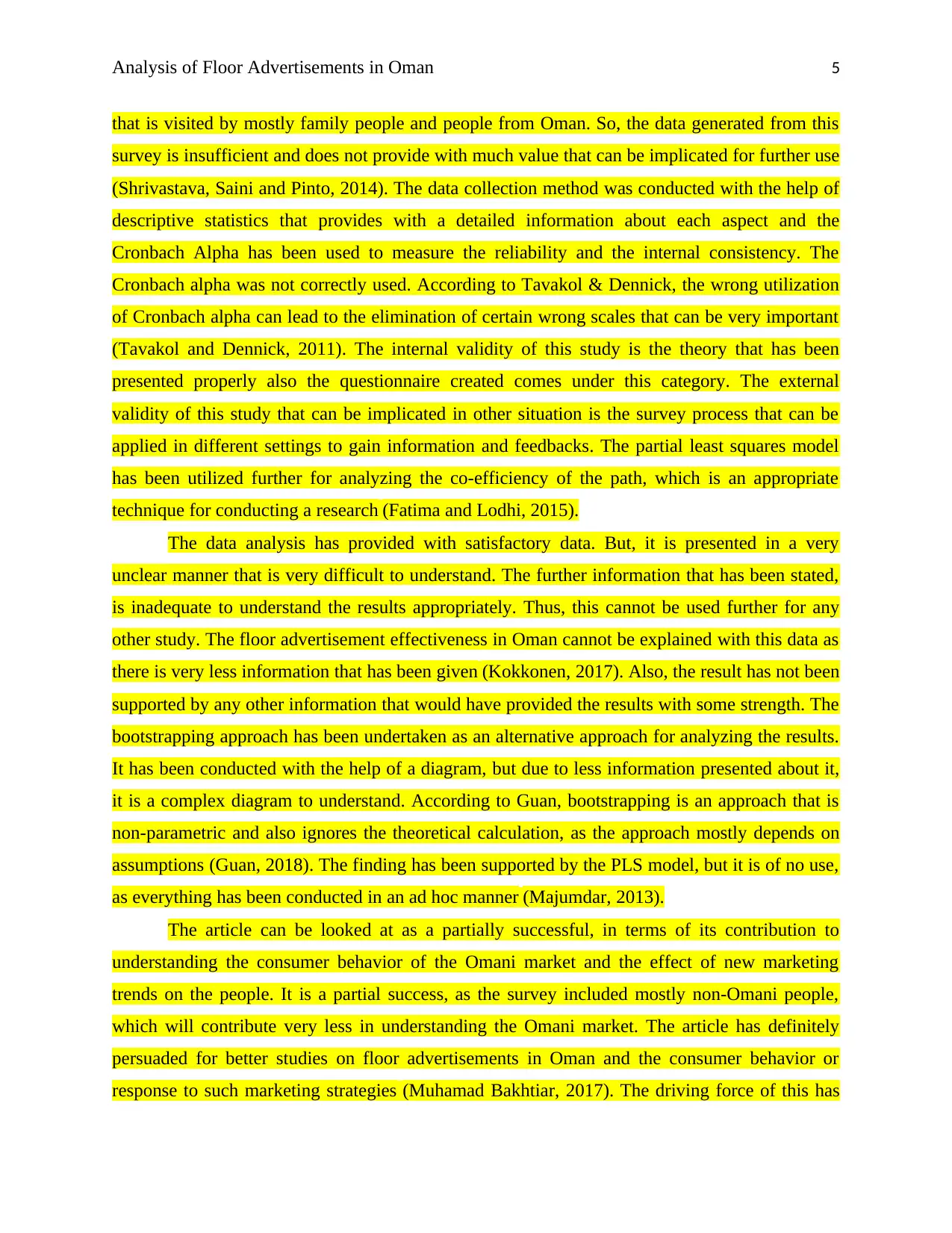
Analysis of Floor Advertisements in Oman 5
that is visited by mostly family people and people from Oman. So, the data generated from this
survey is insufficient and does not provide with much value that can be implicated for further use
(Shrivastava, Saini and Pinto, 2014). The data collection method was conducted with the help of
descriptive statistics that provides with a detailed information about each aspect and the
Cronbach Alpha has been used to measure the reliability and the internal consistency. The
Cronbach alpha was not correctly used. According to Tavakol & Dennick, the wrong utilization
of Cronbach alpha can lead to the elimination of certain wrong scales that can be very important
(Tavakol and Dennick, 2011). The internal validity of this study is the theory that has been
presented properly also the questionnaire created comes under this category. The external
validity of this study that can be implicated in other situation is the survey process that can be
applied in different settings to gain information and feedbacks. The partial least squares model
has been utilized further for analyzing the co-efficiency of the path, which is an appropriate
technique for conducting a research (Fatima and Lodhi, 2015).
The data analysis has provided with satisfactory data. But, it is presented in a very
unclear manner that is very difficult to understand. The further information that has been stated,
is inadequate to understand the results appropriately. Thus, this cannot be used further for any
other study. The floor advertisement effectiveness in Oman cannot be explained with this data as
there is very less information that has been given (Kokkonen, 2017). Also, the result has not been
supported by any other information that would have provided the results with some strength. The
bootstrapping approach has been undertaken as an alternative approach for analyzing the results.
It has been conducted with the help of a diagram, but due to less information presented about it,
it is a complex diagram to understand. According to Guan, bootstrapping is an approach that is
non-parametric and also ignores the theoretical calculation, as the approach mostly depends on
assumptions (Guan, 2018). The finding has been supported by the PLS model, but it is of no use,
as everything has been conducted in an ad hoc manner (Majumdar, 2013).
The article can be looked at as a partially successful, in terms of its contribution to
understanding the consumer behavior of the Omani market and the effect of new marketing
trends on the people. It is a partial success, as the survey included mostly non-Omani people,
which will contribute very less in understanding the Omani market. The article has definitely
persuaded for better studies on floor advertisements in Oman and the consumer behavior or
response to such marketing strategies (Muhamad Bakhtiar, 2017). The driving force of this has
that is visited by mostly family people and people from Oman. So, the data generated from this
survey is insufficient and does not provide with much value that can be implicated for further use
(Shrivastava, Saini and Pinto, 2014). The data collection method was conducted with the help of
descriptive statistics that provides with a detailed information about each aspect and the
Cronbach Alpha has been used to measure the reliability and the internal consistency. The
Cronbach alpha was not correctly used. According to Tavakol & Dennick, the wrong utilization
of Cronbach alpha can lead to the elimination of certain wrong scales that can be very important
(Tavakol and Dennick, 2011). The internal validity of this study is the theory that has been
presented properly also the questionnaire created comes under this category. The external
validity of this study that can be implicated in other situation is the survey process that can be
applied in different settings to gain information and feedbacks. The partial least squares model
has been utilized further for analyzing the co-efficiency of the path, which is an appropriate
technique for conducting a research (Fatima and Lodhi, 2015).
The data analysis has provided with satisfactory data. But, it is presented in a very
unclear manner that is very difficult to understand. The further information that has been stated,
is inadequate to understand the results appropriately. Thus, this cannot be used further for any
other study. The floor advertisement effectiveness in Oman cannot be explained with this data as
there is very less information that has been given (Kokkonen, 2017). Also, the result has not been
supported by any other information that would have provided the results with some strength. The
bootstrapping approach has been undertaken as an alternative approach for analyzing the results.
It has been conducted with the help of a diagram, but due to less information presented about it,
it is a complex diagram to understand. According to Guan, bootstrapping is an approach that is
non-parametric and also ignores the theoretical calculation, as the approach mostly depends on
assumptions (Guan, 2018). The finding has been supported by the PLS model, but it is of no use,
as everything has been conducted in an ad hoc manner (Majumdar, 2013).
The article can be looked at as a partially successful, in terms of its contribution to
understanding the consumer behavior of the Omani market and the effect of new marketing
trends on the people. It is a partial success, as the survey included mostly non-Omani people,
which will contribute very less in understanding the Omani market. The article has definitely
persuaded for better studies on floor advertisements in Oman and the consumer behavior or
response to such marketing strategies (Muhamad Bakhtiar, 2017). The driving force of this has
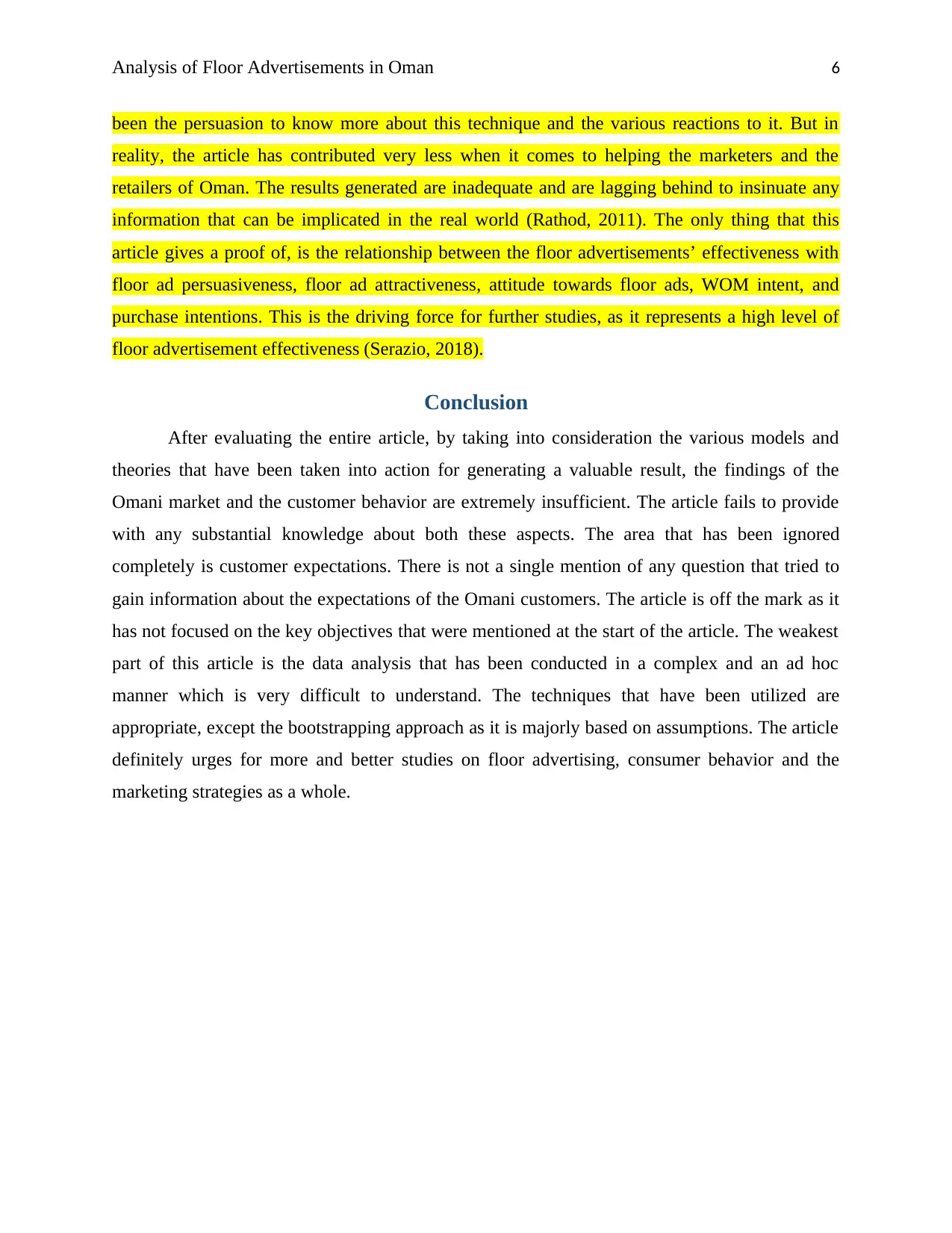
Analysis of Floor Advertisements in Oman 6
been the persuasion to know more about this technique and the various reactions to it. But in
reality, the article has contributed very less when it comes to helping the marketers and the
retailers of Oman. The results generated are inadequate and are lagging behind to insinuate any
information that can be implicated in the real world (Rathod, 2011). The only thing that this
article gives a proof of, is the relationship between the floor advertisements’ effectiveness with
floor ad persuasiveness, floor ad attractiveness, attitude towards floor ads, WOM intent, and
purchase intentions. This is the driving force for further studies, as it represents a high level of
floor advertisement effectiveness (Serazio, 2018).
Conclusion
After evaluating the entire article, by taking into consideration the various models and
theories that have been taken into action for generating a valuable result, the findings of the
Omani market and the customer behavior are extremely insufficient. The article fails to provide
with any substantial knowledge about both these aspects. The area that has been ignored
completely is customer expectations. There is not a single mention of any question that tried to
gain information about the expectations of the Omani customers. The article is off the mark as it
has not focused on the key objectives that were mentioned at the start of the article. The weakest
part of this article is the data analysis that has been conducted in a complex and an ad hoc
manner which is very difficult to understand. The techniques that have been utilized are
appropriate, except the bootstrapping approach as it is majorly based on assumptions. The article
definitely urges for more and better studies on floor advertising, consumer behavior and the
marketing strategies as a whole.
been the persuasion to know more about this technique and the various reactions to it. But in
reality, the article has contributed very less when it comes to helping the marketers and the
retailers of Oman. The results generated are inadequate and are lagging behind to insinuate any
information that can be implicated in the real world (Rathod, 2011). The only thing that this
article gives a proof of, is the relationship between the floor advertisements’ effectiveness with
floor ad persuasiveness, floor ad attractiveness, attitude towards floor ads, WOM intent, and
purchase intentions. This is the driving force for further studies, as it represents a high level of
floor advertisement effectiveness (Serazio, 2018).
Conclusion
After evaluating the entire article, by taking into consideration the various models and
theories that have been taken into action for generating a valuable result, the findings of the
Omani market and the customer behavior are extremely insufficient. The article fails to provide
with any substantial knowledge about both these aspects. The area that has been ignored
completely is customer expectations. There is not a single mention of any question that tried to
gain information about the expectations of the Omani customers. The article is off the mark as it
has not focused on the key objectives that were mentioned at the start of the article. The weakest
part of this article is the data analysis that has been conducted in a complex and an ad hoc
manner which is very difficult to understand. The techniques that have been utilized are
appropriate, except the bootstrapping approach as it is majorly based on assumptions. The article
definitely urges for more and better studies on floor advertising, consumer behavior and the
marketing strategies as a whole.
Paraphrase This Document
Need a fresh take? Get an instant paraphrase of this document with our AI Paraphraser
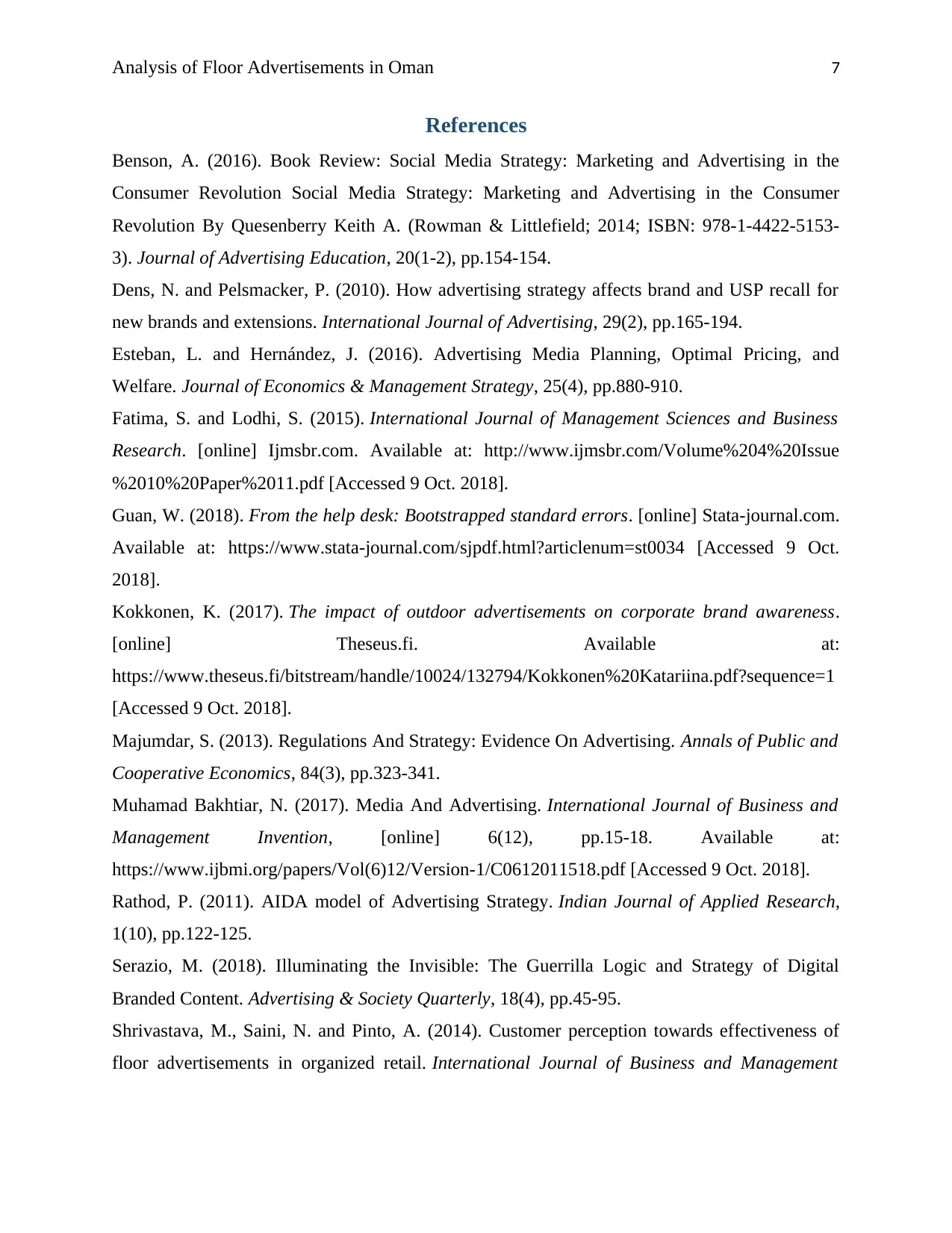
Analysis of Floor Advertisements in Oman 7
References
Benson, A. (2016). Book Review: Social Media Strategy: Marketing and Advertising in the
Consumer Revolution Social Media Strategy: Marketing and Advertising in the Consumer
Revolution By Quesenberry Keith A. (Rowman & Littlefield; 2014; ISBN: 978-1-4422-5153-
3). Journal of Advertising Education, 20(1-2), pp.154-154.
Dens, N. and Pelsmacker, P. (2010). How advertising strategy affects brand and USP recall for
new brands and extensions. International Journal of Advertising, 29(2), pp.165-194.
Esteban, L. and Hernández, J. (2016). Advertising Media Planning, Optimal Pricing, and
Welfare. Journal of Economics & Management Strategy, 25(4), pp.880-910.
Fatima, S. and Lodhi, S. (2015). International Journal of Management Sciences and Business
Research. [online] Ijmsbr.com. Available at: http://www.ijmsbr.com/Volume%204%20Issue
%2010%20Paper%2011.pdf [Accessed 9 Oct. 2018].
Guan, W. (2018). From the help desk: Bootstrapped standard errors. [online] Stata-journal.com.
Available at: https://www.stata-journal.com/sjpdf.html?articlenum=st0034 [Accessed 9 Oct.
2018].
Kokkonen, K. (2017). The impact of outdoor advertisements on corporate brand awareness.
[online] Theseus.fi. Available at:
https://www.theseus.fi/bitstream/handle/10024/132794/Kokkonen%20Katariina.pdf?sequence=1
[Accessed 9 Oct. 2018].
Majumdar, S. (2013). Regulations And Strategy: Evidence On Advertising. Annals of Public and
Cooperative Economics, 84(3), pp.323-341.
Muhamad Bakhtiar, N. (2017). Media And Advertising. International Journal of Business and
Management Invention, [online] 6(12), pp.15-18. Available at:
https://www.ijbmi.org/papers/Vol(6)12/Version-1/C0612011518.pdf [Accessed 9 Oct. 2018].
Rathod, P. (2011). AIDA model of Advertising Strategy. Indian Journal of Applied Research,
1(10), pp.122-125.
Serazio, M. (2018). Illuminating the Invisible: The Guerrilla Logic and Strategy of Digital
Branded Content. Advertising & Society Quarterly, 18(4), pp.45-95.
Shrivastava, M., Saini, N. and Pinto, A. (2014). Customer perception towards effectiveness of
floor advertisements in organized retail. International Journal of Business and Management
References
Benson, A. (2016). Book Review: Social Media Strategy: Marketing and Advertising in the
Consumer Revolution Social Media Strategy: Marketing and Advertising in the Consumer
Revolution By Quesenberry Keith A. (Rowman & Littlefield; 2014; ISBN: 978-1-4422-5153-
3). Journal of Advertising Education, 20(1-2), pp.154-154.
Dens, N. and Pelsmacker, P. (2010). How advertising strategy affects brand and USP recall for
new brands and extensions. International Journal of Advertising, 29(2), pp.165-194.
Esteban, L. and Hernández, J. (2016). Advertising Media Planning, Optimal Pricing, and
Welfare. Journal of Economics & Management Strategy, 25(4), pp.880-910.
Fatima, S. and Lodhi, S. (2015). International Journal of Management Sciences and Business
Research. [online] Ijmsbr.com. Available at: http://www.ijmsbr.com/Volume%204%20Issue
%2010%20Paper%2011.pdf [Accessed 9 Oct. 2018].
Guan, W. (2018). From the help desk: Bootstrapped standard errors. [online] Stata-journal.com.
Available at: https://www.stata-journal.com/sjpdf.html?articlenum=st0034 [Accessed 9 Oct.
2018].
Kokkonen, K. (2017). The impact of outdoor advertisements on corporate brand awareness.
[online] Theseus.fi. Available at:
https://www.theseus.fi/bitstream/handle/10024/132794/Kokkonen%20Katariina.pdf?sequence=1
[Accessed 9 Oct. 2018].
Majumdar, S. (2013). Regulations And Strategy: Evidence On Advertising. Annals of Public and
Cooperative Economics, 84(3), pp.323-341.
Muhamad Bakhtiar, N. (2017). Media And Advertising. International Journal of Business and
Management Invention, [online] 6(12), pp.15-18. Available at:
https://www.ijbmi.org/papers/Vol(6)12/Version-1/C0612011518.pdf [Accessed 9 Oct. 2018].
Rathod, P. (2011). AIDA model of Advertising Strategy. Indian Journal of Applied Research,
1(10), pp.122-125.
Serazio, M. (2018). Illuminating the Invisible: The Guerrilla Logic and Strategy of Digital
Branded Content. Advertising & Society Quarterly, 18(4), pp.45-95.
Shrivastava, M., Saini, N. and Pinto, A. (2014). Customer perception towards effectiveness of
floor advertisements in organized retail. International Journal of Business and Management

Analysis of Floor Advertisements in Oman 8
Invention, [online] 3(1), pp.11-19. Available at: https://www.ijbmi.org/papers/Vol(3)1/Version-
3/B0313011019.pdf [Accessed 9 Oct. 2018].
Tavakol, M. and Dennick, R. (2011). International Journal of Medical Education. [online]
Ijme.net. Available at: https://www.ijme.net/archive/2/cronbachs-alpha.pdf [Accessed 9 Oct.
2018].
Invention, [online] 3(1), pp.11-19. Available at: https://www.ijbmi.org/papers/Vol(3)1/Version-
3/B0313011019.pdf [Accessed 9 Oct. 2018].
Tavakol, M. and Dennick, R. (2011). International Journal of Medical Education. [online]
Ijme.net. Available at: https://www.ijme.net/archive/2/cronbachs-alpha.pdf [Accessed 9 Oct.
2018].
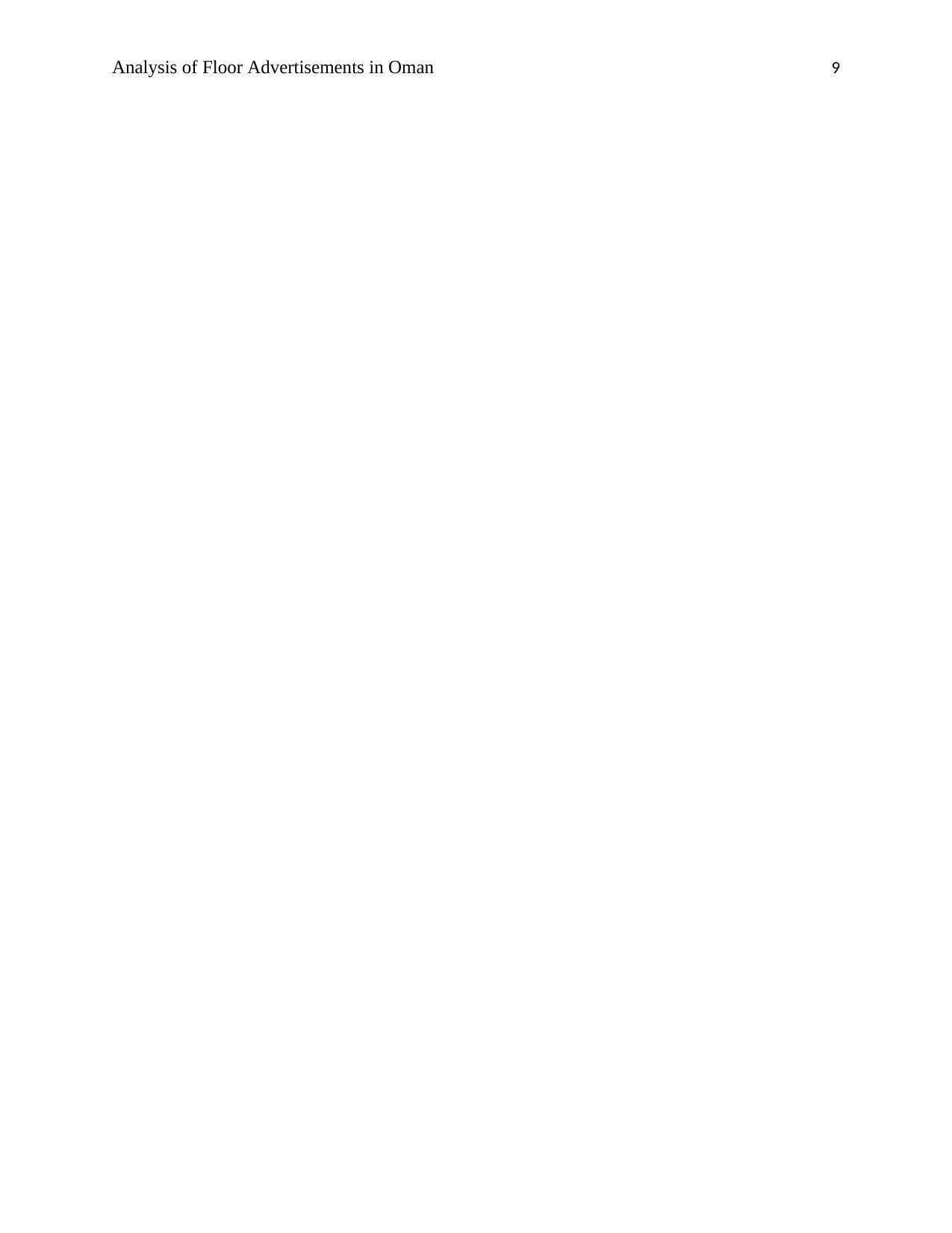
Analysis of Floor Advertisements in Oman 9
1 out of 10
Related Documents
Your All-in-One AI-Powered Toolkit for Academic Success.
+13062052269
info@desklib.com
Available 24*7 on WhatsApp / Email
![[object Object]](/_next/static/media/star-bottom.7253800d.svg)
Unlock your academic potential
© 2024 | Zucol Services PVT LTD | All rights reserved.





